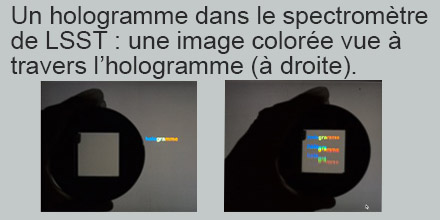
The GREEN team from IJCLab's A2C Pole has proposed a hologram to improve the performance of the Large Synoptic Survey Telescope (LSST) spectograph installed in Chile. The LSST is to measure the luminosity of billions of astrophysical objects through broadband filters. These measurements will be affected by atmospheric absorption, depending on the wavelength, and which changes with weather conditions. To correct this effect and go back to luminosities "outside the atmosphere", an auxiliary telescope (AuxTel, diameter 1.20m), equipped with a spectrograph, will produce in real time the standard star spectra to be compared with the spectra outside the atmosphere known by space observatories.
The key element of the spectrograph, a periodic grating that spreads light in the colors of the rainbow, produces out-of-focus and distortion. The hologram proposed by the IJCLab team avoids these 2 limitations. This optical component can in fact combine the functions of light disperser and lens, and refocus the deflected beam. An ordinary lattice is a plane streaked with periodic straight lines, while the hologram is a plane covered with neither quite straight nor quite periodic lines, obtained by photographic recording of interference figures from two point sources. Prototypes of holograms tested in mid-2017 on a 0.90m telescope in Chile gave good results (publication to be published). The GREEN team therefore initiated R&D to produce a high-performance hologram for AuxTel. Several prototypes were studied on the 1m telescope of the Pic du Midi, and with a telescope beam simulator, installed on an optical bench at the LPNHE. The final hologram mounted on AuxTel since February has given very promising results. Due to the pandemic, the installation had to be supervised remotely, and contact with the local team took place overnight.























